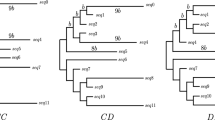Abstract
Acritical step in all quartet methods for constructing evolutionary trees is the inference of the topology for each set of four sequences (i.e. quartet). It is a well—known fact that all quartet topology inference methods make mistakes that result in the incorrect inference of quartet topology. These mistakes are called quartet errors. In this paper, two efficient algorithms for correcting bounded numbers of quartet errors are presented. These “quartet cleaning” algorithms are shown to be optimal in that no algorithm can correct more quartet errors. An extensive simulation study reveals that sets of quartet topologies inferred by three popular methods (Neighbor Joining [15], Ordinal Quartet [14] and Maximum Parsimony [10]) almost always contain quartet errors and that a large portion of these quartet errors are corrected by the quartet cleaning algorithms.
Supported in part by ESPRIT LTR Project no. 20244 — ALCOM-IT.
Supported in part by NSERC Research Grant OGP0046613 and a CGAT grant.
Supported in part by NSERC Research Grant OGP217246-99 and a CITO grant.
Supported in part by NSERC Research Grant OGP0046506, CITO, a CGAT grant, and the Steacie Fellowship.
Supported in part by a CGAT grant.
Access this chapter
Tax calculation will be finalised at checkout
Purchases are for personal use only
Preview
Unable to display preview. Download preview PDF.
Similar content being viewed by others
References
A. Ben-Dor, B. Chor, D. Graur, R. Ophir, and D. Pellep. From four-taxon trees to phylogenies: The case of mammalian evolution. Proceedings of the Second Annual International Conference on Computational Molecular Biology, pages 9–19, 1998.
V. Berry and O. Gascuel. Inferring evolutionary trees with strong combinatorial evidence. Proceedings of the Third Annual International Computing and Combinatorics Conference, pages 111–123, 1997.
M. Boguski. Bioinformatics — a new era. In S. Brenner, F. Lewitter, M. Patterson, and M. Handel, editors, Trends Guide to Bioinformatics, pages 1–3. Elsevier Science, 1998.
D. Bryant. Structures in Biological Classification. Ph.D. Thesis, Department of Mathematics and Statistics, University of Canterbury, 1997.
P. Buneman. The recovery of trees from measures of dissimilarity. In F. R. Hodson, D. G. Kendall, and P. Tautu, editors, Mathematics in the Archaeological and Historical Sciences, pages 387–395. Edinburgh University Press, Edinburgh, 1971.
M. A. Charleston, M. D. Hendy, and D. Penny. The effects of sequence length, tree topology, and number of taxa on the performance of phylogenetic methods. Journal of Computational Biology, 1(2):133–152, 1994.
G. Della Vedova. An improved algorithm for local vertex cleaning. Manuscript, 1998.
P. Erdös, M. Steel, L. Székely, and T. Warnow. Constructing big trees from short sequences. Proceedings of the 24th International Colloquium on Automata, Languages, and Programming, 1997.
J. Felsenstein. Evolutionary trees from DNA sequences: A maximum likelihood approach. Journal of Molecular Evolution, 17:368–376, 1981.
W. M. Fitch. Toward defining the course of evolution: Minimal change for a specific tree topology. Systematic Zoology, 20:406–41, 1971.
V. A. Funk and D. R. Brooks. Phylogenetic Systematics as the Basis for Comparative Biology. Smithsonian Institution Press, 1990.
R. Gupta and B. Golding. Evolution of hsp70 gene and its implications regarding relationships between archaebacteria, eubacteria and eukaryotes. Journal of Molecular Evolution, 37:573–582, 1993.
T. Jiang, P. E. Kearney, and M. Li. Orchestrating quartets: Approximation and data correction. Proceedings of the 39th IEEE Symposium on Foundations of Computer Science, pages 416–425, 1998.
P. E. Kearney. The ordinal quartet method. Proceedings of the Second Annual International Conference on Computational Molecular Biology, pages 125–134, 1998.
N. Saitou and M. Nei. The neighbor-joining method: A new method for reconstructing phylogenetic trees. Molecular Biology and Evolution, 4:406–425, 1987.
M. Steel. The complexity of reconstructing trees from qualitative characters and subtrees. Journal of Classification, 9:91–116, 1992.
K. Strimmer and A. von Haeseler. Quartet puzzling: A quartet maximum-likelihood method for reconstructing tree topologies. Molecular Biology and Evolution, 13(7):964–969, 1996.
D. L. Swofford, G. J. Olsen, P. J. Waddell, and D. M Hillis. Phylogenetic inference. In D. M. Hillis, C. Moritz, and B. K. Mable, editors, Molecular Systematics, 2nd Edition, pages 407–514. Sinauer Associates, Sunderland, Massachusetts, 1996.
L. Vigilant, M. Stoneking, H. Harpending, H. Hawkes, and A. C. Wilson. African populations and the evolution of human mitochondrial DNA. Science, 253:1503–1507, 1991.
Z. Yang. PAML: a program package for phylogenetic analysis by maximum likelihood. CABIOS, 15:555–556, 1997.
Author information
Authors and Affiliations
Editor information
Editors and Affiliations
Rights and permissions
Copyright information
© 1999 Springer-Verlag Berlin Heidelberg
About this paper
Cite this paper
Berry, V., Jiang, T., Kearney, P., Li, M., Wareham, T. (1999). Quartet Cleaning: Improved Algorithms and Simulations. In: Nešetřil, J. (eds) Algorithms - ESA’ 99. ESA 1999. Lecture Notes in Computer Science, vol 1643. Springer, Berlin, Heidelberg. https://doi.org/10.1007/3-540-48481-7_28
Download citation
DOI: https://doi.org/10.1007/3-540-48481-7_28
Published:
Publisher Name: Springer, Berlin, Heidelberg
Print ISBN: 978-3-540-66251-8
Online ISBN: 978-3-540-48481-3
eBook Packages: Springer Book Archive




